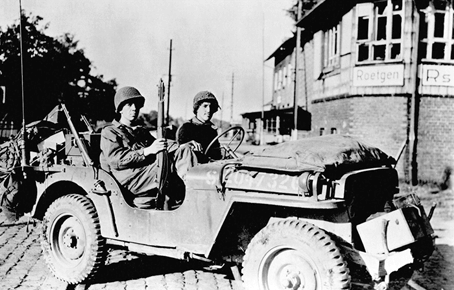| Year | 1941 |
| Vehicle Type | [@type] |
| Origin & Designer | [@designer] |
| Numbers Produced | 629.325 |
| Crew | 1 + 3 Passengers |
| Armament | 1 x .30 cal M1919A4 or 1 x .50 cal M2HB H.M.G |
| Ammunition Carried | [@ammunition_carried] |
| Pay Load | 363 kg |
| Towed Load | 454 kg |
| Weight | 1.625 kg |
| Height | 1.77m |
| Width | 1.57m |
| Length | 3.36m |
| Ground Clearance | 0.22m |
| Fording Depth | 0.46m |
| Obstacle Clearance | [@obstacle_clearance] |
| Climbing Ability | 30° (Towing 45°) |
| Radio | [@radio] |
| Armour | [@armour] |
| Engine | Willys 4 cyl. 441/442 Go Devil (Petrol) |
| Transmission | 3 x Forward & 1 x Reverse |
| Maximum Road Range | 299 miles (482 km) |
| Maximum Cross Country Range | [@maximum_cross_country_range] |
| Maximum Road Speed | 65 mph (110 kph) |
| Maximum Road Speed + Trailer | 19 mph (32 kph) |
| Maximum Cross Country Speed | 29 mph (50 kph) |
| Maximum Road Towing Speed | [@maximum_road_towing_speed] |
| Variants | [@variants] |
| Notes | Out the outbreak of WW2 the US army required the need for a light cross country vehicle with four wheel drive that could be used in the reconnaissance role. Proposals were submitted resulting in three main bids from Bantam, Willys and Ford. Bantam was first to offer a pilot model in just 49 days and this was delivered to the army for tests. It was soon realised that Bantam could not deliver the required number needed by the army, so both Willys and Ford were given the go ahead to study the blue prints of the Bantam design and each submitted a prototype. Willys came up with the “Quad” and Ford the “Pygmy”. The army initially accepted all three designs but by 1941 decided to standardise and accepted an order from Willys due to its latest model the “Go Devil” which had a more powerful engine. Later in the year it was apparent that Willys could not keep up demand so Ford was brought in to produce models under licence. The Willys MB and the Ford GPW models were issued alongside each other and functioned in the same roles. During WW2 Willys produced 363.000 and Ford 280.000. The jeep was one of the most important light vehicles used by the US Army. It served right through WW2 and in Korea, and later its successor the M151 (MUTT) doing a similar role in Vietnam. |
